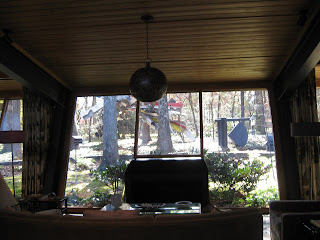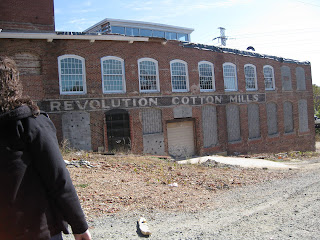The main connector I am going to discuss are the coffee shops in Greensboro. They are everywhere!! I looked at three specifically and they all had a different focus. The first one is the Tate Street Coffee House.


When you walk in, you are greeted by the cashier. The tables run up down the side of the room. It was decorated all over; colored strings and ornaments hanging from the ceiling, pictures and art on the walls, and some Christmas decorations as well. The main focus seemed to be

 busyness. All the decorations and the set up gave it a crowded look and feeling. When in there, I felt like I was in the way. http://www.tatestreetcoffee.com/
busyness. All the decorations and the set up gave it a crowded look and feeling. When in there, I felt like I was in the way. http://www.tatestreetcoffee.com/

 The second coffee shop is the Catitude Café on West Market
The second coffee shop is the Catitude Café on West Market Street. It is owned and run by Catherine Johnson. Her shop is set up very different from the Tate Street Coffee House; it is very open and homey feeling.
Street. It is owned and run by Catherine Johnson. Her shop is set up very different from the Tate Street Coffee House; it is very open and homey feeling.She has some tables set up and a couple sitting areas with couches and big comfy chairs. She had little quotes painted on the
 wall and a game area in the front corner. A very unique aspect that I noticed was that she had a very Christian
wall and a game area in the front corner. A very unique aspect that I noticed was that she had a very Christian  theme set up. http://juicecafeandgallery.com/default.html
theme set up. http://juicecafeandgallery.com/default.html 

“My reason for opening a coffee shop was to provide a place for friends and family to congregate without things like underage drinking present.” –Catherine Johnson


The last coffee place I looked is the Green Bean Coffeehouse on South Elm Street. It was very open and spaced out.
The ceilings are high which adds to the openness. When walking into the shop, you see all the shelves that are set up for community news. They also
 have a table set up to display Petfinder-an animal adoption agency. The
have a table set up to display Petfinder-an animal adoption agency. The  focus seems to be community service and such. http://www.yelp.com/biz/green-bean-greensboro
focus seems to be community service and such. http://www.yelp.com/biz/green-bean-greensboroAll three coffee houses seem to be great and I look forward to trying each out someday.
Another big
 connector would be the roadways. All roads lead somewhere from so
connector would be the roadways. All roads lead somewhere from so mewhere. The main roads coming in and out of Greensboro would be the interstates and the US routes. An interstate route is a network of limited-access highways. They are widely spread and cover the entire United States, running through all the states about equally.
mewhere. The main roads coming in and out of Greensboro would be the interstates and the US routes. An interstate route is a network of limited-access highways. They are widely spread and cover the entire United States, running through all the states about equally. 

The US routes are the important regional connections.
They through all the states about equally.
Greensboro is part of 840, 85, and 40. run throughout the whole
 United States but fill most of the Eastern side. Greensboro is part of 421, 220, 70, and 29. These are the roads tha
United States but fill most of the Eastern side. Greensboro is part of 421, 220, 70, and 29. These are the roads tha t connect the people and resources of Greensboro with the people and resources of other cities, regions, and states.
t connect the people and resources of Greensboro with the people and resources of other cities, regions, and states.Just as with any other city, region, or state, Greensboro has its own personal
 road system. These are the roads that connect residency areas with retail areas with industrial
road system. These are the roads that connect residency areas with retail areas with industrial  areas. Roadways are probably the most important connector for everywhere and everyone.
areas. Roadways are probably the most important connector for everywhere and everyone.

 The Moses Cone Memorial Hospital is the next connector. Hospitals all over the world connect people for joy (birth and healing) and grief (death and sickness).
The Moses Cone Memorial Hospital is the next connector. Hospitals all over the world connect people for joy (birth and healing) and grief (death and sickness).The Moses Cone is located on North Elm Street positioning it a few blocks from the center of Greensboro.

This is important because a hospital is where life, healing, and death
 occur. A hospital is capable of connecting people who haven’t spoken in days, months, or even years. http://www.mosescone.com/
occur. A hospital is capable of connecting people who haven’t spoken in days, months, or even years. http://www.mosescone.com/
Libraries are very important connectors. A library is any collection of books, articles, or videos. They connect people with the knowledge stored in books, articles, and videos. When I say they connect people, I’m talking about people in the past, present, and future. Libraries can be found almost anywhere; homes, churches, and schools all include a sort of library.
Most of the knowledge we have comes from what those from the past have written about the events.

The Greensboro Public Library is located on North Church Street. The front of the
 building draws people from the front and from both sides. The lobby is a big open space that allows for people to gather. This particular library has several gathering spaces other than the main book room and the lobby.
building draws people from the front and from both sides. The lobby is a big open space that allows for people to gather. This particular library has several gathering spaces other than the main book room and the lobby.The largest space is the Nussbaum Room, used as a meeting room with audio and visual capabilities. The other space is the Tannenbaum/Sternberger Room. This space can b
 e divided into two separate spaces or used as one bug space.
e divided into two separate spaces or used as one bug space.Both spaces are used for workshops, corporate meetings, and small receptions. The library also includes a computer lab which, with internet, is an international connector. There are reading areas all throughout the book room where you can just relax and enjoy the book of your choice. Without libraries, we would be without a lot of the connections that we take for granted during everyday life. http://www.greensboro-nc.gov/departments/library

For a lot of people, churches are a very big connector. They help the connection between God and people grow while connecting people with each other spiritually. I looked specifically at the West Market Street United Methodist Church.
This church, as most others, offers a  lot of opportunities to come for recreation,
lot of opportunities to come for recreation,  worship, and fellowship. These are all important assets for a church. They include a daycare, during services, and an adult library as well. http://www.wmsumc.org/
worship, and fellowship. These are all important assets for a church. They include a daycare, during services, and an adult library as well. http://www.wmsumc.org/

The Apple Store is the main international connection. As we all know, their big products are computers, phones, and music devices.
The computer and phone connect us with anyone anywhere. The music devices, the IPods, are becoming capable of this connection as well. 
The Apple Store at the Friendly Center on West Friendly Avenue allows for Greensboro to have access to these connections. http://www.apple.com/retail/friendlycenter















